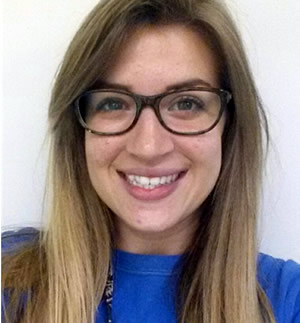By Olivia S. Rissland
 After receiving a B.S. in biochemistry and B.A. in chemistry from the University of Buffalo, Dr. Kim Stanek pursued graduate studies at the University of Virginia. Passionate about gene regulation—especially for how bacteria are able to quickly respond and adapt to their changing environment—her interests were a natural fit for the lab of Dr. Cameron Mura, whose research investigates the evolutionary link between the bacterial RNA chaperon Hfq and eukaryotic Sm proteins. Dr. Stanek’s graduate work has focused on the structure and function of the Hfq homolog from Novophingobium bacterium, which has two linked Sm domains. “We found that this protein has some interesting oligomeric properties that should provide insight into the evolutionary transition from homomeric Hfq proteins to heteromeric Sm proteins.”
After receiving a B.S. in biochemistry and B.A. in chemistry from the University of Buffalo, Dr. Kim Stanek pursued graduate studies at the University of Virginia. Passionate about gene regulation—especially for how bacteria are able to quickly respond and adapt to their changing environment—her interests were a natural fit for the lab of Dr. Cameron Mura, whose research investigates the evolutionary link between the bacterial RNA chaperon Hfq and eukaryotic Sm proteins. Dr. Stanek’s graduate work has focused on the structure and function of the Hfq homolog from Novophingobium bacterium, which has two linked Sm domains. “We found that this protein has some interesting oligomeric properties that should provide insight into the evolutionary transition from homomeric Hfq proteins to heteromeric Sm proteins.”
When Dr. Stanek embarked on her graduate project, she had no experience in structural biology—but it wasn’t long until she fell in love with crystallography. Her passion extended beyond her lab work, and she became heavily involved in the American Crystallographic Association (ACA): she co-chaired sessions at their annual conference, wrote articles for Reflexion (the ACA quarterly publication), and organized an x-ray crystallography workshop for high school students. “Getting involved was a great way to see what goes on behind the scenes,” Dr. Stanek explained, “and it also allows you to make connections with investigators you may not have otherwise met.” She added, “I’m also proud that historically crystallography, like the RNA field, has a strong representation of women in the field, including Rosalind Franklin, Dorothy Hodgkin, Jane Richardson, and Ada Yonath. Seeing such female representation has been really empowering.”
“My hope is that by talking about mental health issues, we can end the stigma behind them so that
students aren’t too embarrassed or ashamed to find help”
Dr. Stanek is also passionate about making graduate student mental health better. “I have actually struggled with depression for a long time,” she explained. “I finally shared my experience with close friends and family, which led me to seek the treatment that I needed.” For Dr. Stanek, it was important to “figure out a work-life balance during my graduate studies, to find hobbies outside of the lab, and to take time for myself so that I didn’t get burnt out.” She continued, “I think this is something that a lot of graduate students may be dealing with, but that just isn’t openly discussed. My hope is that by talking about mental health issues, we can end the stigma behind them so that students aren’t too embarrassed or ashamed to find help.”
Dr. Stanek received her Ph.D. earlier this year and just started her post-doctoral research with Dr. Celia Goulding at University of California–Irvine. She found that conferences provided a key opportunity to find a post-doctoral position. She explained, “I think face-to-face interactions are the best way to make a good impression and learn about research opportunities in other labs. It’s also useful to talk to other graduate students and post-docs from the group to get an idea of the lab environment.” Certainly this was the case for Dr. Stanek at the 2017 RNA Society meeting in Prague. “I met people in my field and made lasting personal and professional connections,” she said. “Plus, the Junior Scientists organize very informative professional development sessions—one of my favorites was on combating imposter syndrome.”
The other highlight from the annual meeting in Prague? The banquet on the final night: “The closing event had a DJ, and by the end of the night, we had a room full of RNA biologists dancing!”
Dr. Stanek’s favorite RNA is the bacterial small RNA RydC, which folds into a compact pseudoknot. Its structure was described in a recent paper (Dimastrogiovanni et al. 2014), which “beautifully showed how a single sRNA could bind to multiple sites on the Hfq ring and answered a lot of questions about the mechanism of Hfq function.”
